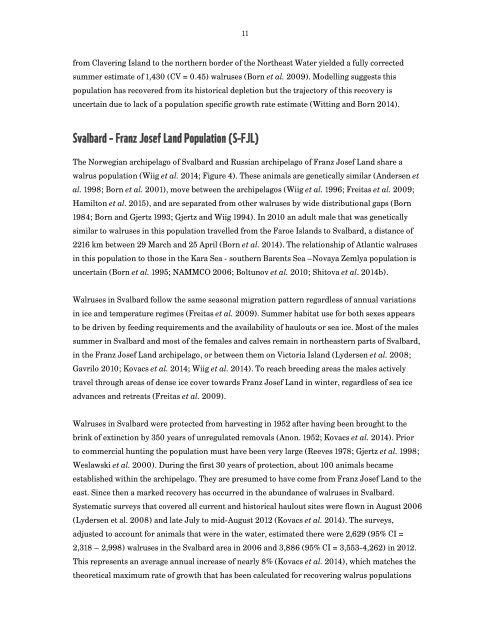The State of Circumpolar Walrus Populations
walrusreport
walrusreport
You also want an ePaper? Increase the reach of your titles
YUMPU automatically turns print PDFs into web optimized ePapers that Google loves.
11<br />
from Clavering Island to the northern border <strong>of</strong> the Northeast Water yielded a fully corrected<br />
summer estimate <strong>of</strong> 1,430 (CV = 0.45) walruses (Born et al. 2009). Modelling suggests this<br />
population has recovered from its historical depletion but the trajectory <strong>of</strong> this recovery is<br />
uncertain due to lack <strong>of</strong> a population specific growth rate estimate (Witting and Born 2014).<br />
Svalbard – Franz Josef Land Population (S-FJL)<br />
<strong>The</strong> Norwegian archipelago <strong>of</strong> Svalbard and Russian archipelago <strong>of</strong> Franz Josef Land share a<br />
walrus population (Wiig et al. 2014; Figure 4). <strong>The</strong>se animals are genetically similar (Andersen et<br />
al. 1998; Born et al. 2001), move between the archipelagos (Wiig et al. 1996; Freitas et al. 2009;<br />
Hamilton et al. 2015), and are separated from other walruses by wide distributional gaps (Born<br />
1984; Born and Gjertz 1993; Gjertz and Wiig 1994). In 2010 an adult male that was genetically<br />
similar to walruses in this population travelled from the Faroe Islands to Svalbard, a distance <strong>of</strong><br />
2216 km between 29 March and 25 April (Born et al. 2014). <strong>The</strong> relationship <strong>of</strong> Atlantic walruses<br />
in this population to those in the Kara Sea - southern Barents Sea –Novaya Zemlya population is<br />
uncertain (Born et al. 1995; NAMMCO 2006; Boltunov et al. 2010; Shitova et al. 2014b).<br />
<strong>Walrus</strong>es in Svalbard follow the same seasonal migration pattern regardless <strong>of</strong> annual variations<br />
in ice and temperature regimes (Freitas et al. 2009). Summer habitat use for both sexes appears<br />
to be driven by feeding requirements and the availability <strong>of</strong> haulouts or sea ice. Most <strong>of</strong> the males<br />
summer in Svalbard and most <strong>of</strong> the females and calves remain in northeastern parts <strong>of</strong> Svalbard,<br />
in the Franz Josef Land archipelago, or between them on Victoria Island (Lydersen et al. 2008;<br />
Gavrilo 2010; Kovacs et al. 2014; Wiig et al. 2014). To reach breeding areas the males actively<br />
travel through areas <strong>of</strong> dense ice cover towards Franz Josef Land in winter, regardless <strong>of</strong> sea ice<br />
advances and retreats (Freitas et al. 2009).<br />
<strong>Walrus</strong>es in Svalbard were protected from harvesting in 1952 after having been brought to the<br />
brink <strong>of</strong> extinction by 350 years <strong>of</strong> unregulated removals (Anon. 1952; Kovacs et al. 2014). Prior<br />
to commercial hunting the population must have been very large (Reeves 1978; Gjertz et al. 1998;<br />
Weslawski et al. 2000). During the first 30 years <strong>of</strong> protection, about 100 animals became<br />
established within the archipelago. <strong>The</strong>y are presumed to have come from Franz Josef Land to the<br />
east. Since then a marked recovery has occurred in the abundance <strong>of</strong> walruses in Svalbard.<br />
Systematic surveys that covered all current and historical haulout sites were flown in August 2006<br />
(Lydersen et al. 2008) and late July to mid-August 2012 (Kovacs et al. 2014). <strong>The</strong> surveys,<br />
adjusted to account for animals that were in the water, estimated there were 2,629 (95% CI =<br />
2,318 – 2,998) walruses in the Svalbard area in 2006 and 3,886 (95% CI = 3,553-4,262) in 2012.<br />
This represents an average annual increase <strong>of</strong> nearly 8% (Kovacs et al. 2014), which matches the<br />
theoretical maximum rate <strong>of</strong> growth that has been calculated for recovering walrus populations


